Community-Based Microgrids: Literature Review and Pathways to Decarbonise the Local Electricity Network
Abstract
:1. Introduction
- DER integration and innovative incentivisation;
- Making consumers active to deliver to and get support from the flexible energy system;
- New consumer-centric market and business models.
- Ancillary services to the grid/inter-community microgrids;
- Multi-scale storage management (small, medium, large scale storage);
- Computational complexity on network trading and simulations;
- Maximum power injection limit on inverters;
- Regulation and grid code compliance on max capacity installation (prosumer with large storage installed capacity can earn more revenue);
- Network tariff based on the utilisation of part of the network;
- Avoiding conflicts among stakeholders (DSO, Retailer) based on personal interests;
- Real-time coordination from the top level (DSO, C-MG operator) to the bottom level (prosumer assets);
- A systematic evaluation of the existing literature and construction of a generalised framework for C-MG.
- All feasible C-MG structure/topology on the basis of DER and grid integration are summarised and evaluated.
- The investigation of interoperability in the context of the development of a C-MG.
- In contrast, this review also provides a comprehensive understanding of the consumer-centric local electricity market that would be suitable for C-MG structures.
- The opportunities and constraints of socioeconomic elements in the context of creating C-MG are also explored.
2. Methodology
- Architectural framework: Smart grid and microgrid networks should have a common architectural framework. When the microgrid structures/topologies are more concerned with closer integration at the community level to engage and empower consumers, the social aspect is an important issue there. Does the existing framework then consider this issue?
- C-MG Structure: Different types of structures exist in the research, development and demonstration space. All the existing solutions have some pros and cons when it comes to the benefit of consumers as well as the network operators. From the energy-active consumer point of view (including consumers with demand response facilities, prosumers), what type of microgrid structures could be most beneficial for their active participation in the energy transition?
- Interoperability: When it comes to microgrids/C-MG solutions, researchers are rarely focused on interoperability issues. In most cases, the importance of interoperability is also not clear. In cases of C-MGs, how can communication among the DERs, active consumers, and operators within the microgrids, as well as their interactions with the smart grid for ancillary services/flexibility, be achieved?
- Market integration: Local Electricity Market (LEM) concepts are developing and getting more important in energy communities. However, LEM impacts on the distribution network are not well researched. Considering the same impact in the microgrid networks, what type of C-MG structures could be more suitable for active consumers to participate in local electricity trading/sharing? In relation to consumer engagement, how they can participate in the wholesale electricity market (WEM) as well?
- Social aspect: It is well accepted that microgrids have lots of technical, economical, and environmental benefits. The integration of microgrids in energy communities to empower energy citizens and identify the social benefits is not well researched yet. The literature on microgrids needs to be assessed to identify the social research methods associated with the development process of C-MGs. What type of C-MG structure could be beneficial for the community users to increase their social bonding? How could a Living Lab methodology benefit society in managing and operating the local energy community-based microgrids?
3. C-MG Architecture
3.1. Reported Architecture
3.2. Proposed Architecture for Designing C-MG
3.2.1. Physical Layer
3.2.2. ICT Layer
3.2.3. Control Layer
- Real-time balancing energy consumption and demand in the community microgrids
- Network performance control (power quality, power flow, outage etc.)
- Resource identification and allocation for appropriate action
- Provision of decisions for effective market participation
3.2.4. Market and Business Layer
3.2.5. Regulation Layer
4. C-MG Topology/Structure
4.1. General Structures
4.1.1. Centralised Structure
4.1.2. Distributed Structure
4.1.3. Decentralised Structure
4.2. C-MG Structures Based on DER Integration
5. Interoperability
6. Market Integration
6.1. Prosumers beyond Self-Consumption
- Trigger local sustainability projects that drive energy independence, reduce emissions, reduce fuel poverty and generate local jobs [72].
- Encourage investment in new projects by increasing democratic control over energy investments [73]. This can increase the acceptance of RES installations and simplify the planning process in communities.
- Generate financial returns by creating a mechanism for reinvestment or reallocation of energy revenues directly in host communities, for example, by profit sharing or dividends.
- Mobilise citizens by enabling joint action for addressing local issues, for example, climate change or air pollution.
- Increase the visibility of energy use among consumers, thereby driving the uptake of energy efficiency measures.
- Reduce energy costs and lower network tariffs, as well as improve fairness in relation to the socialisation of grid costs [74].
- Improve social cohesion.
6.2. Impact of LEM on Microgrids and Possibility to Improve by Integrating It into the Wholesale Market
7. Social Aspects
8. Findings and Recommendations
- Architectural framework: The review finds that a generalised architecture needs to be developed for microgrids/community-based microgrid solutions so that, in the future, C-MG solutions can easily be integrated with the smart grid network. Hence, the proposed C-MG architectural framework is kept very much aligned with the SGAM layers. In addition, consumers and communities with C-MG solutions will have easy access to, and participate in, the future LEM/WEM, along with their socio-economic benefits. The proposed architecture has a special focus in this direction as well. Future research and demonstration work should focus on all of these dimensions in their studies.
- C-MG Structure: This paper also generalised the C-MG structures first based on the control approach (centralised, distributed and decentralised) and then based on the DER integration. Both issues are very important with respect to utility support, end-user integration, and active participation in the future market point of view. With respect to the main performance criteria, such as complexity, scaling, decentralisation of DERs, and the degree of participation by consumers (prosumers), the decentralised and distributed C-MG approaches could be more supportive for consumers and community engagement, reducing the DER monopoly and easy scalability. On the other hand, these will have more complexity in control and communication along with future WEM participation. Research also requires more attention to increase the advantages in centralised conditions, as it has less complexity in control, comparatively it is more grid supportive/flexible and the social engagement/benefit is also high (C-MG2, 4, 5, 7—as shown in Table 6).
- Interoperability: This is one of the key elements for enabling C-MG solutions in practice. Compared to a decade ago, large steps forwards have been made, partially under the impulse of the European Standardisation Mandates. IEEE and IEC have also come forward. These initiatives have resulted in a clear inventarisation and characterisation of relevant standards and thus provided a path (with the SGAM and C-MG architecture) to discuss interoperability at different levels. Most importantly, the standards do not impose or prohibit any technical solutions from being used but provide a guideline for authorities and incentives involved stakeholders to implement future-proof solutions. This article also shows the initial connectivity of C-MG and SGAM layers through the interoperability mechanism. Literature review finds massive gaps here. Further research is required in this direction.
- Market integration: The proper design of the electricity market with the greater involvement of consumers and the wholesale market is highly recommended for the smooth development of a C-MG. Until now, individual/small-scale P2P energy transitions are restricted, as the existing business models are highly reliant on a centralised pool structure. Proper coordination of LEM and the WEM is required to ensure the consumer takes advantage of the new business model. However, consumer-centric P2P energy trading is a great concern for potential grid congestion. The new business model should deeply consider the existing grid infrastructure and services, where peers (individual/community) should lend a hand for grid operation to enhance resilience and flexibility. In this respect, C-MG structures with centralised control (operated and managed by microgrid operator/LEMO) can be the best choice for future local energy communities (C-MG4, 5—as shown in Table 6). Depending on the control mechanism, multiple cluster-based microgrids and LEM (C-MG7) can also be beneficial for the utility, consumer and community.
- Social aspect: One of the core values of introducing community-based microgrid solutions/structures is to increase the social engagement of the energy citizens in the community. Through this involvement, community citizens would believe that environment-friendly clean energy solutions and the operation of microgrids through active management systems can enhance the quality of their life and the lives of their neighbours. Though a good number of projects are already being demonstrated globally, the social values of the successful operation and management of C-MG solutions are not sufficiently addressed yet. Easy operation, utility-supportive and market participation aspects could further encourage the energy citizens to increase the social bonding by developing C-MG solutions (C-MG4, seven types of solutions could be the best options). The Living Lab approach could be one of the best ways to understand the social benefits of implementing C-MG solutions in real energy communities.
9. Conclusions
Author Contributions
Funding
Acknowledgments
Conflicts of Interest
References
- Integrated Local Energy Systems (Energy Islands): International Cooperation with India|Euraxess. Available online: https://euraxess.ec.europa.eu/worldwide/india/integrated-local-energy-systems-energy-islands-international-cooperation-india (accessed on 17 January 2022).
- ERA-Net Smart Energy Systems: Innovation for Smart Energy Systems in Europe. Available online: https://www.eranet-smartenergysystems.eu/ (accessed on 17 January 2022).
- European Parliament. Directive 2019/944 on Common Rules for the Internal Market for Electricity. Off. J. Eur. Union 2019, 50, 30. [Google Scholar]
- Caramizaru, A.; Uihlein, A. Energy Communities: An Overview of Energy and Social Innovation, EUR 30083 EN; Publications Office of the European Union: Luxembourg, 2020. [Google Scholar] [CrossRef]
- Tenti, P.; Caldognetto, T. A General Approach to Select Location and Ratings of Energy Storage Systems in Local Area Energy Networks. IEEE Trans. Ind. Appl. 2019, 55, 6203–6210. [Google Scholar] [CrossRef]
- Paudel, A.; Chaudhari, K.; Long, C.; Gooi, H.B. Peer-to-Peer Energy Trading in a Prosumer-Based Community Microgrid: A Game-Theoretic Model. IEEE Trans. Ind. Electron. 2019, 66, 6087–6097. [Google Scholar] [CrossRef]
- Tedesco, F.; Mariam, L.; Basu, M.; Casavola, A.; Conlon, M.F. Economic Model Predictive Control-Based Strategies for Cost-Effective Supervision of Community Microgrids Considering Battery Lifetime. IEEE J. Emerg. Sel. Top. Power Electron. 2015, 3, 1067–1077. [Google Scholar] [CrossRef]
- Rosado, S.P.; Khadem, S.K. Development of Community Grid: Review of Technical Issues and Challenges. IEEE Trans. Ind. Appl. 2019, 55, 1171–1179. [Google Scholar] [CrossRef]
- Taft, J.D. Grid Architecture: A Core Discipline for Grid Modernization. IEEE Power Energy Mag. 2019, 17, 18–28. [Google Scholar] [CrossRef]
- Forum, E. Pan-European Forum for R & I on Smart Grids, Flexibility and Local Energy Networks. 2020–2021. Available online: https://pantera-platform.eu/wp-content/uploads/2021/02/PANTERA-D2.3.pdf. (accessed on 17 November 2021).
- Haney, A.B.; Pollitt, M.G. New models of public ownership in energy. Int. Rev. Appl. Econ. 2013, 27, 174–192. [Google Scholar] [CrossRef]
- Council of European Energy Regulators (CEER) CEER 2022–2025 Strategy Empowering Consumers for the Energy Transition. 2021. Available online: https://www.ceer.eu/documents/104400/-/-/4a783339-46cb-1e8c-c3de-c0fe7ea52076 (accessed on 17 November 2021).
- Transition, L.E.; Neutrality, C. CEER-BEUC 2030 VISION Long-term Energy Transition for Sustainability and Climate Neutrality: Long-term Energy Transition for Sustainability and Climate Neutrality. Available online: https://ec.europa.eu/clima/eu-action/climate-strategies-targets/2050-long-term-strategy_en. (accessed on 17 November 2021).
- Syed, M.M.; Morrison, G.M. A Rapid Review on Community Connected Microgrids. Sustainability 2021, 13, 6753. [Google Scholar] [CrossRef]
- Cox, D.J. Microgrid Infrastructure Modeling for Residential Microgrids. In Proceedings of the 2007 IEEE Power Engineering Society General Meeting, Tampa, FL, USA, 24–28 June 2007; pp. 1–6. [Google Scholar] [CrossRef]
- Wu, L.; Ortmeyer, T.; Li, J. The community microgrid distribution system of the future. Electr. J. 2016, 29, 16–21. [Google Scholar] [CrossRef]
- Bourgeois, T.; Gerow, J.; Litz, F.; Martin, N. Community Microgrids: Smarter, Cleaner. Pace Energy Clim. Cent. 2013, 1–23. Available online: http://nyssmartgrid.com/wp-content/uploads/Pace-Energy-and-Climate-Center-Community-Microgrids.pdf. (accessed on 21 December 2021).
- Council of European Energy Regulators. Regulatory Aspects of Self-Consumption and Energy Communities; CEER Report C18-CRM9_DS7-05-03; Council of European Energy Regulators asbl: Brussels, Belgium, 2019; p. 53. [Google Scholar]
- Gui, E.M.; Diesendorf, M.; MacGill, I. Distributed energy infrastructure paradigm: Community microgrids in a new institutional economics context. Renew. Sustain. Energy Rev. 2017, 72, 1355–1365. [Google Scholar] [CrossRef]
- Zhang, C.; Wu, J.; Zhou, Y.; Cheng, M.; Long, C. Peer-to-Peer energy trading in a Microgrid. Appl. Energy 2018, 220, 1–12. [Google Scholar] [CrossRef]
- Paladin, A.; Das, R.; Wang, Y.; Ali, Z.; Kotter, R.; Putrus, G.; Turri, R. Micro market based optimisation framework for decentralised management of distributed flexibility assets. Renew. Energy 2021, 163, 1595–1611. [Google Scholar] [CrossRef]
- Bruinenberg, J.; Colton, L.; Darmois, E.; Dorn, J.; Doyle, J.; Elloumi, O.; Englert, H.; Forbes, R.; Heiles, J.; Hermans, P.; et al. CEN-CENELEC-ETSI: Smart Grid Coordination Group—Smart Grid Reference Architecture Report 2.0. 2012. Available online: https://ec.europa.eu/energy/sites/ener/files/documents/xpert_group1_reference_architecture.pdf (accessed on 30 December 2021).
- Mazzola, L.; Denzler, A.; Christen, R. Peer-to-Peer Energy Trading in Microgrids: Towards an Integrated Open and Distributed Market. In Proceedings of the 2020 International Conference on Electrical Engineering and Control Technologies (CEECT), Melbourne, VIC, Australia, 10–13 December 2020; pp. 1–10. [Google Scholar] [CrossRef]
- Martin-Martínez, F.; Sánchez-Miralles, A.; Rivier, M. A literature review of Microgrids: A functional layer based classification. Renew. Sustain. Energy Rev. 2016, 62, 1133–1153. [Google Scholar] [CrossRef]
- Vaahedi, E.; Nodehi, K.; Heim, D.; Rahimi, F.; Ipakchi, A. The Emerging Transactive Microgrid Controller: Illustrating Its Concept, Functionality, and Business Case. IEEE Power Energy Mag. 2017, 15, 80–87. [Google Scholar] [CrossRef]
- Carpintero-Rentería, M.; Santos-Martín, D.; Guerrero, J.M. Microgrids literature review through a layers structure. Energies 2019, 12, 4381. [Google Scholar] [CrossRef] [Green Version]
- Siano, P.; De Marco, G.; Rolán, A.; Loia, V. A Survey and Evaluation of the Potentials of Distributed Ledger Technology for Peer-to-Peer Transactive Energy Exchanges in Local Energy Markets. IEEE Syst. J. 2019, 13, 3454–3466. [Google Scholar] [CrossRef]
- Trivedi, R.; Khadem, S. Peak Demand Management and Schedule Optimisation for Energy Storage through the Machine Learning Approaches. In Proceedings of the IEEE EUROCON 2021—19th International Conference on Smart Technologies, Lviv, Ukraine, 6–8 July 2021; pp. 157–163. [Google Scholar] [CrossRef]
- Hatziargyriou, N. Microgrids: Architectures and Control, 1st ed.; Wiley-IEEE Press: Chichester, UK, 2014; ISBN 978-1-118-72068-4. [Google Scholar]
- Tao, L.; Schwaegerl, C.; Narayanan, S.; Zhang, J.H. From laboratory Microgrid to real markets—Challenges and opportunities. In Proceedings of the 8th International Conference on Power Electronics—ECCE, Jeju, Korea, 30 May–3 June 2011; pp. 264–271. [Google Scholar] [CrossRef]
- More Microgrids Report on the Technical, Social, Economic, and Environmental Benefits Provided by Microgrids on Power System Operation. WPG. Evaluation of the System Performance on Power System Operation. 2009. Available online: http://www.microgrids.eu/documents/668.pdf (accessed on 30 December 2021).
- Shamsi, P.; Xie, H.; Longe, A.; Joo, J.Y. Economic Dispatch for an Agent-Based Community Microgrid. IEEE Trans. Smart Grid 2016, 7, 2317–2324. [Google Scholar] [CrossRef]
- Hyytinen, K.; Toivonen, M. Future energy services: Empowering local communities and citizens. Foresight 2015, 17, 349–364. [Google Scholar] [CrossRef]
- Bentley, E.; Kotter, R.; Wang, Y.; Das, R.; Putrus, G.; Van Der Hoogt, J.; Van Bergen, E.; Warmerdam, J.; Heller, R.; Jablonska, B. Pathways to energy autonomy—Challenges and opportunities. Int. J. Environ. Stud. 2019, 76, 893–921. [Google Scholar] [CrossRef]
- Gill, S.; Plecas, M.; Kockar, I. Coupling Demand and Distributed Generation to Accelerate Renewable Connections: Options for the Accelerating Renewable Connections Project; University of Strathclyde: Glasgow, UK, 2014. [Google Scholar]
- Roberts, M.B.; Bruce, A.; MacGill, I. Opportunities and barriers for photovoltaics on multi-unit residential buildings: Reviewing the Australian experience. Renew. Sustain. Energy Rev. 2019, 104, 95–110. [Google Scholar] [CrossRef]
- Parra, D.; Swierczynski, M.; Stroe, D.I.; Norman, S.A.; Abdon, A.; Worlitschek, J.; O’Doherty, T.; Rodrigues, L.; Gillott, M.; Zhang, X.; et al. An interdisciplinary review of energy storage for communities: Challenges and perspectives. Renew. Sustain. Energy Rev. 2017, 79, 730–749. [Google Scholar] [CrossRef]
- Mariam, L. Modelling of an Intelligent Microgrid System in a Smart Grid Network; Technological University Dublin: Dublin, Ireland, 2018. [Google Scholar] [CrossRef]
- Gui, E.M.; MacGill, I. Typology of future clean energy communities: An exploratory structure, opportunities, and challenges. Energy Res. Soc. Sci. 2018, 35, 94–107. [Google Scholar] [CrossRef]
- Zou, H.; Mao, S.; Wang, Y.; Zhang, F.; Chen, X.; Cheng, L. A Survey of Energy Management in Interconnected Multi-Microgrids. IEEE Access 2019, 7, 72158–72169. [Google Scholar] [CrossRef]
- Carrión, G.A.; Cintrón, R.A.; Rodríguez, M.A.; Sanabria, W.E.; Reyes, R.; O’Neill-Carrillo, E. Community Microgrids to Increase Local Resiliency. In Proceedings of the 2018 IEEE International Symposium on Technology and Society (ISTAS), Washington, DC, USA, 13–14 November 2018; pp. 1–7. [Google Scholar] [CrossRef]
- Burmester, D.; Rayudu, R.; Seah, W.; Akinyele, D. A review of nanogrid topologies and technologies. Renew. Sustain. Energy Rev. 2017, 67, 760–775. [Google Scholar] [CrossRef]
- Ajaei, F.B.; Mohammadi, J.; Stevens, G.; Akhavan, E. Hybrid AC/DC microgrid configurations for a net-zero energy community. In Proceedings of the 2019 IEEE/IAS 55th Industrial and Commercial Power Systems Technical Conference (I&CPS), Calgary, AB, Canada, 5–8 May 2019. [Google Scholar] [CrossRef]
- Warneryd, M.; Håkansson, M.; Karltorp, K. Unpacking the complexity of community microgrids: A review of institutions’ roles for development of microgrids. Renew. Sustain. Energy Rev. 2020, 121, 109690. [Google Scholar] [CrossRef]
- Suk, H.; Yadav, A.; Hall, J. Scalability considerations in the design of microgrids to support socioeconomic development in rural communities. ASME Int. Mech. Eng. Congr. Expo. Proc. 2018, 13, 1–9. [Google Scholar] [CrossRef]
- Soshinskaya, M.; Crijns-Graus, W.H.J.; Guerrero, J.M.; Vasquez, J.C. Microgrids: Experiences, barriers and success factors. Renew. Sustain. Energy Rev. 2014, 40, 659–672. [Google Scholar] [CrossRef] [Green Version]
- Alvial-Palavicino, C.; Garrido-Echeverría, N.; Jiménez-Estévez, G.; Reyes, L.; Palma-Behnke, R. A methodology for community engagement in the introduction of renewable based smart microgrid. Energy Sustain. Dev. 2011, 15, 314–323. [Google Scholar] [CrossRef]
- Gollwitzer, L. Community-Based Micro Grids: A Common Property Resource Problem; STEPS Centre: Brighton, UK, 2014. [Google Scholar]
- Gopstein, A.; Nguyen, C.; Byrnett, D.S.; Worthington, K.; Villarreal, C. Framework and Roadmap for Smart Grid Interoperability Standards regional Roundtables Summary Report; National Institute of Standards and Technology (NIST): Gaithersburg, MD, USA, 2020. [Google Scholar]
- FERRAZ, F.S. IDeM: An Identity-Driven Middleware for Interoperable and Heterogeneous Systems; Universidade Federal de Pernambuco: Recife, Brazil, 2016. [Google Scholar]
- Basso, T. IEEE 1547 and 2030 Standards for Distributed Energy Resources Interconnection and Interoperability with the Electricity Grid; National Renewable Energy Lab. (NREL): Golden, CO, USA, 2014. [Google Scholar] [CrossRef] [Green Version]
- European Commission M441. 2009. Available online: https://ec.europa.eu/growth/tools-databases/mandates/index.cfm?fuseaction=search.detail&id=421# (accessed on 17 November 2021).
- European Commission. Standardization Mandate to CEN, CENELEC and ETSI Concerning the Charging of Electric Vehicles, M/468 EN. European Commission; European Commission: Brussels, Belgium, 2010; Available online: https://ec.europa.eu/growth/tools-databases/mandates/index.cfm?fuseaction=search.detail&id=450 (accessed on 17 November 2021).
- European Commission. M/490 Smart Grid Mandate Standardization Mandate to European Standardisation Organisations (ESOs) to Support European Smart Grid Deployment; European Commission: Brussels, Belgium, 2011; Available online: https://ec.europa.eu/growth/tools-databases/mandates/index.cfm?fuseaction=search.detail&id=475# (accessed on 17 November 2021).
- European Commission. M/530 COMMISSION IMPLEMENTING DECISION C(2015) 102 Final of 20.1.2015; European Commission: Brussels, Belgium, 2015. Available online: https://ec.europa.eu/growth/tools-databases/mandates/index.cfm?fuseaction=search.detail&id=548# (accessed on 17 November 2021).
- IEEE 1547-2018—IEEE Standard for Interconnection and Interoperability of Distributed Energy Resources with Associated Electric Power Systems Interfaces. Available online: https://standards.ieee.org/standard/1547-2018.html (accessed on 14 December 2021).
- IEEE Standards Committee; IEEE Standards Coordinating Committee 21 on Fuel Cells, P.; Institute of Electrical and Electronics Engineers; IEEE-SA Standards Board. IEEE Guide for Smart Grid Interoperability of Energy Technology and Information Technology Operation with the Electric Power System (EPS), End-Use Applications and Loads; IEEE: Piscataway, NJ, USA, 2011; Volume 110. [Google Scholar] [CrossRef]
- P2040—Standard for General Requirements for Fully Automated Vehicles Driving on Public Roads. Available online: https://standards.ieee.org/project/2040_3.html. (accessed on 25 November 2021).
- IEEE SA—IEEE 802. Available online: https://standards.ieee.org/featured/802/index.html (accessed on 25 November 2021).
- IEC 61850:2021 SER|IEC Webstore|LVDC. Available online: https://webstore.iec.ch/publication/6028 (accessed on 25 November 2021).
- IEC 62325-301:2018|IEC Webstore. Available online: https://webstore.iec.ch/publication/31487 (accessed on 25 November 2021).
- IEC—Smart Grid Standards Map. Available online: http://smartgridstandardsmap.com/ (accessed on 28 November 2021).
- Bower, W.I.; Ton, D.T.; Guttromson, R.; Glover, S.F.; Stamp, J.E.; Bhatnagar, D.; Reilly, J. The Advanced Microgrid. Integration and Interoperability; Sandia National Lab.: Albuquerque, NM, USA; Livermore, CA, USA, 2014. [Google Scholar] [CrossRef]
- O’Fallon, C.; Gopstein, A. Economics of Interoperability in the Context of Smart Grid Architectures. NIST Spec. Publ. 1900, 604, 1900-604. [Google Scholar]
- Dudjak, V.; Neves, D.; Alskaif, T.; Khadem, S.; Pena-Bello, A.; Saggese, P.; Bowler, B.; Andoni, M.; Bertolini, M.; Zhou, Y.; et al. Impact of local energy markets integration in power systems layer: A comprehensive review. Appl. Energy 2021, 301, 117434. [Google Scholar] [CrossRef]
- Bjarghov, S.; Löschenbrand, M.; Saif, A.U.N.I.; Pedrero, R.A.; Pfeiffer, C.; Khadem, S.K.; Rabelhofer, M.; Revheim, F.; Farahmand, H. Developments and Challenges in Local Electricity Markets: A Comprehensive Review. IEEE Access 2021, 9, 58910–58943. [Google Scholar] [CrossRef]
- Saif, A.U.N.I.; Khadem, S.K. Consumer-centric Electricity Market: Review of key European projects. In Proceedings of the 2020 17th International Conference on the European Energy Market (EEM), Stockholm, Sweden, 16–18 September 2020; pp. 1–6. [Google Scholar] [CrossRef]
- Ellabban, O.; Abu-Rub, H. Smart grid customers’ acceptance and engagement: An overview. Renew. Sustain. Energy Rev. 2016, 65, 1285–1298. [Google Scholar] [CrossRef]
- Eadson, W.; Bull, R. Citizen Engagement in local Energy Decision-Making: Literature and Policy Background; Sheffield Hallam University: Sheffield, UK, 2020. [Google Scholar] [CrossRef]
- Gupta, R.; Zahiri, S. Enhancing User Engagement in Local Energy Initiatives using Smart Local Energy Engagement Tools (SLEETs). In Proceedings of the 6th European Conference on Behaviour and Energy Efficiency, Copenhagen, Denmark, 21–23 April 2021. [Google Scholar]
- Meeuw, A.; Schopfer, S.; Ryder, B.; Wortmann, F. LokalPower: Enabling local energy markets with user-driven engagement. In Proceedings of the Extended Abstracts of the 2018 CHI Conference on Human Factors in Computing Systems, Montreal, QC, Canada, 20 April 2018. [Google Scholar] [CrossRef] [Green Version]
- Becker, S.; Kunze, C. Transcending community energy: Collective and politically motivated projects in renewable energy (CPE) across Europe. People Place Policy 2014, 8, 180–191. [Google Scholar] [CrossRef] [Green Version]
- Hanna, R.; Ghonima, M.; Kleissl, J.; Tynan, G.; Victor, D.G. Evaluating business models for microgrids: Interactions of technology and policy. Energy Policy 2017, 103, 47–61. [Google Scholar] [CrossRef]
- Abada, I.; Ehrenmann, A.; Lambin, X. On the Viability of Energy Communities. Energy J. 2020, 41, 113–150. [Google Scholar] [CrossRef]
- Ramos, A.; De Jonghe, C.; Gómez, V.; Belmans, R. Realizing the smart grid’s potential: Defining local markets for flexibility. Util. Policy 2016, 40, 26–35. [Google Scholar] [CrossRef]
- Mengelkamp, E.; Staudt, P.; Garttner, J.; Weinhardt, C. Trading on local energy markets: A comparison of market designs and bidding strategies. Int. Conf. Eur. Energy Mark. EEM 2017. [Google Scholar] [CrossRef]
- Lezama, F.; Soares, J.; Hernandez-Leal, P.; Kaisers, M.; Pinto, T.; Vale, Z. Local Energy Markets: Paving the Path Toward Fully Transactive Energy Systems. IEEE Trans. Power Syst. 2019, 34, 4081–4088. [Google Scholar] [CrossRef] [Green Version]
- Kirpes, B.; Mengelkamp, E.; Schaal, G.; Weinhardt, C. Design of a microgrid local energy market on a blockchain-based information system. It-Inf. Technol. 2019, 61, 87–99. [Google Scholar] [CrossRef]
- Brolin, M.; Pihl, H. Design of a local energy market with multiple energy carriers. Int. J. Electr. Power Energy Syst. 2020, 118, 105739. [Google Scholar] [CrossRef]
- Ableitner, L.; Meeuw, A.; Schopfer, S.; Tiefenbeck, V.; Wortmann, F.; Wörner, A. Quartierstrom—Implementation of a Real World Prosumer Centric Local Energy Market in Walenstadt, Switzerland; Cornell Univ: Ithaca, NY, USA, 2019. [Google Scholar]
- Global Observatory on Peer-to-Peer Energy Trading—UsersTCP. Available online: https://userstcp.org/task/peer-to-peer-energy-trading/1121 (accessed on 21 December 2021).
- Schwaegerl, C.; Tao, L. Quantification of Technical, Economic, Environmental and Social Benefits of Microgrid Operation. Microgrids 2013, 275–313. [Google Scholar] [CrossRef]
- Palma-Behnke, R.; Ortiz, D.; Reyes, L.; Jiménez-Estévez, G.; Garrido, N. A social SCADA approach for a renewable based microgrid—The Huatacondo project. IEEE Power Energy Soc. Gen. Meet. 2011. [Google Scholar] [CrossRef]
- Mastelic, J. Stakeholders’ Engagement in the Co-Design of Energy Conservation Interventions; Université de Lausanne: Lausanne, Switzerland, 2019. [Google Scholar]
- Martínez-Cid, R.; O’Neill-Carrillo, E. Sustainable microgrids for isolated systems. In Proceedings of the IEEE PES T&D 2010, New Orleans, LA, USA, 19–22 April 2010. [Google Scholar] [CrossRef]
- Santos, A.Q.; Ma, Z.; Olsen, C.G.; Jørgensen, B.N. Framework for Microgrid Design Using Social, Economic, and Technical Analysis. Energies 2018, 11, 2832. [Google Scholar] [CrossRef] [Green Version]
- Ubilla, K.; Jiménez-Estévez, G.A.; Hernádez, R.; Reyes-Chamorro, L.; Irigoyen, C.H.; Severino, B.; Palma-Behnke, R. Smart microgrids as a solution for rural electrification: Ensuring long-term sustainability through cadastre and business models. IEEE Trans. Sustain. Energy 2014, 5, 1310–1318. [Google Scholar] [CrossRef]
- Bridging the Gap between Open and User Innovation? In Exploring the Value of Living Labs as a Means to Structure User Contribution and Manage Distributed Innovation; Vrije Universiteit Brussel: Brussels, Belgium; Ghent University: Ghent, Belgium, 2015.
- Noun Project: Free Icons & Stock Photos for Everything. Available online: https://thenounproject.com/ (accessed on 10 November 2021).
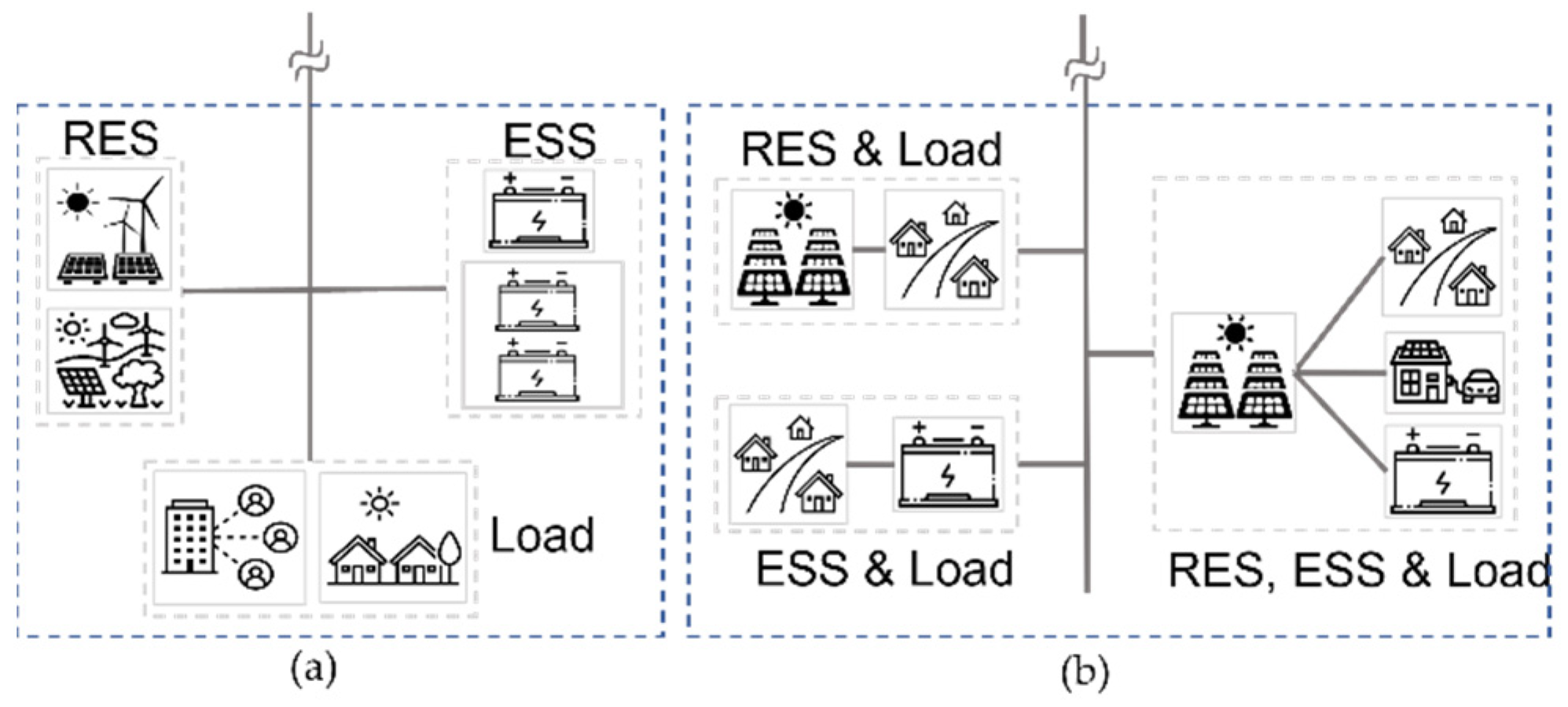
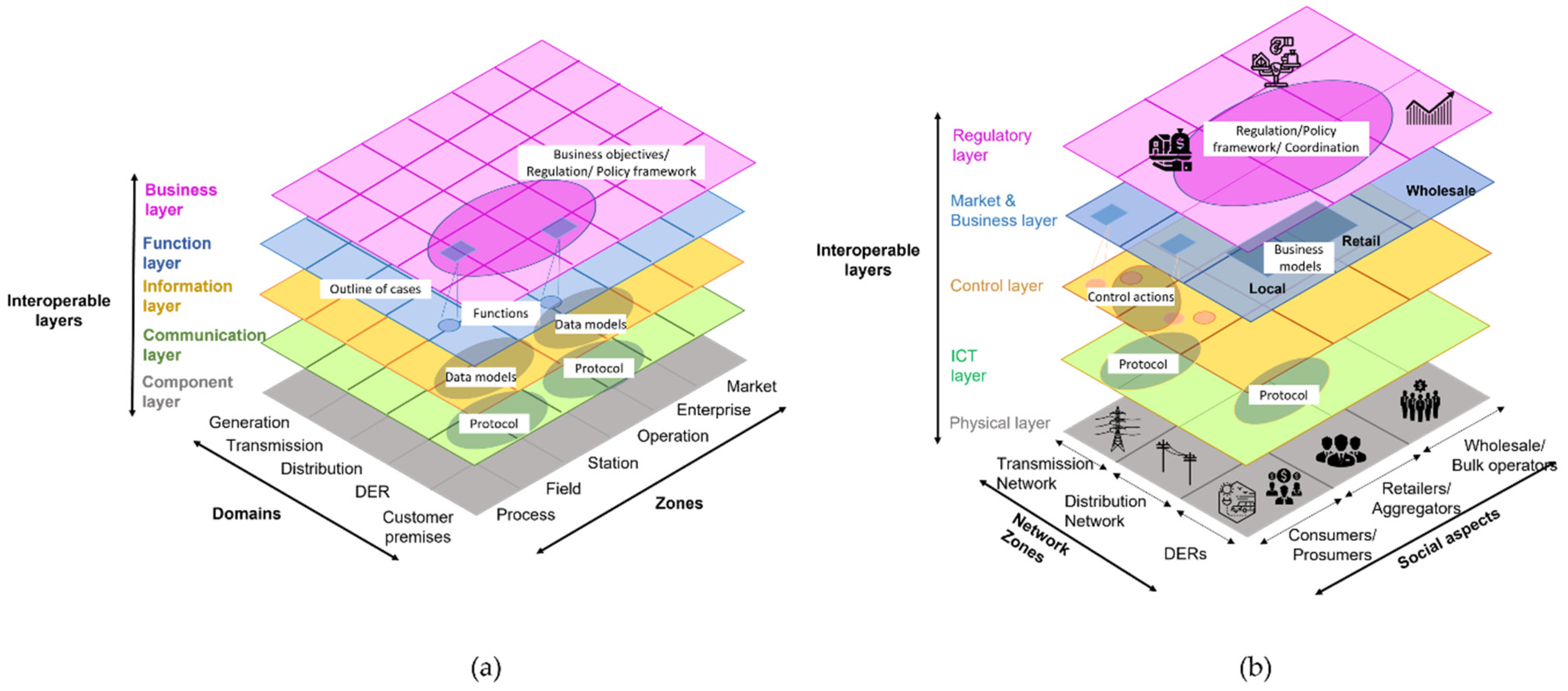
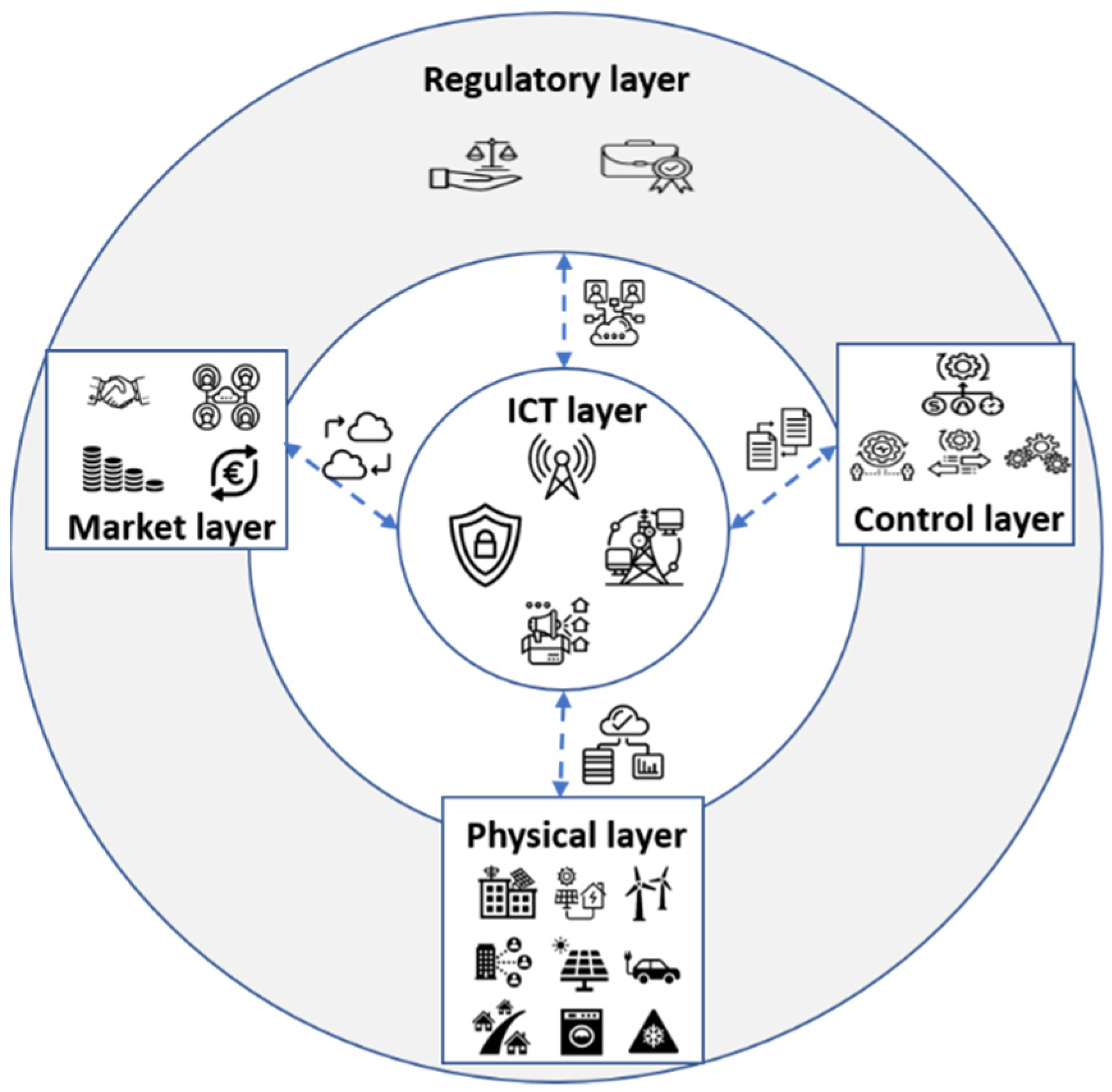
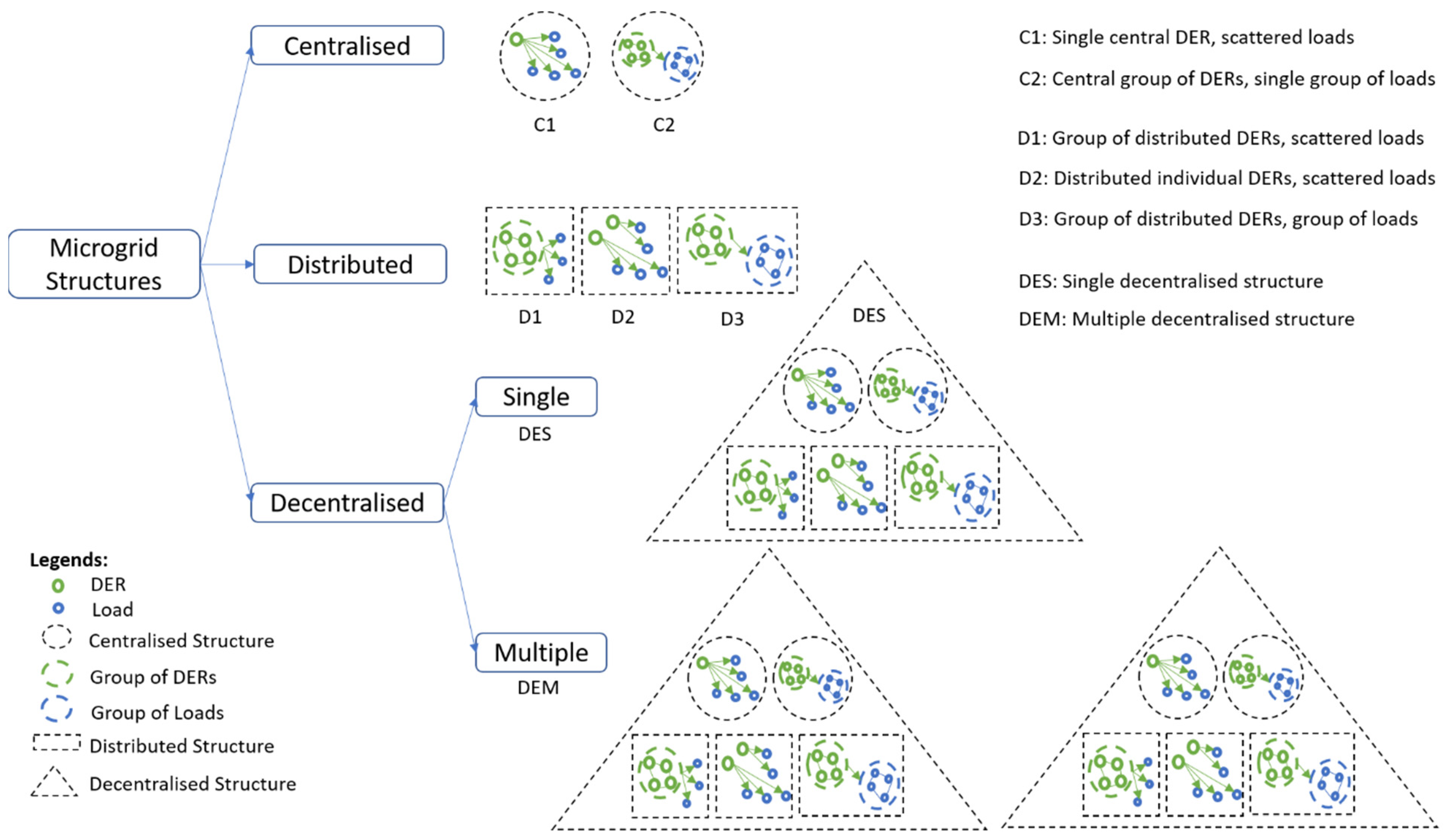

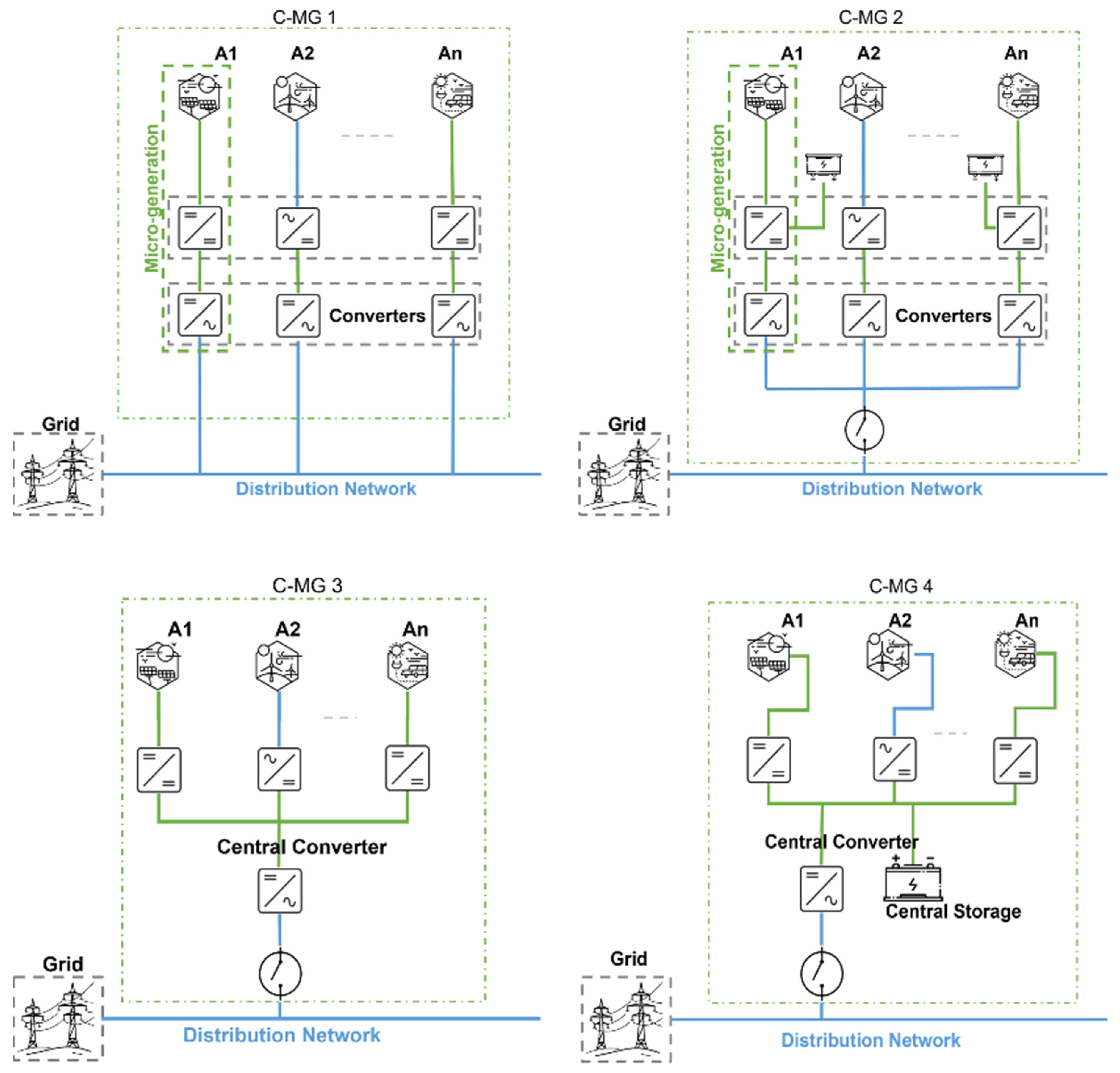
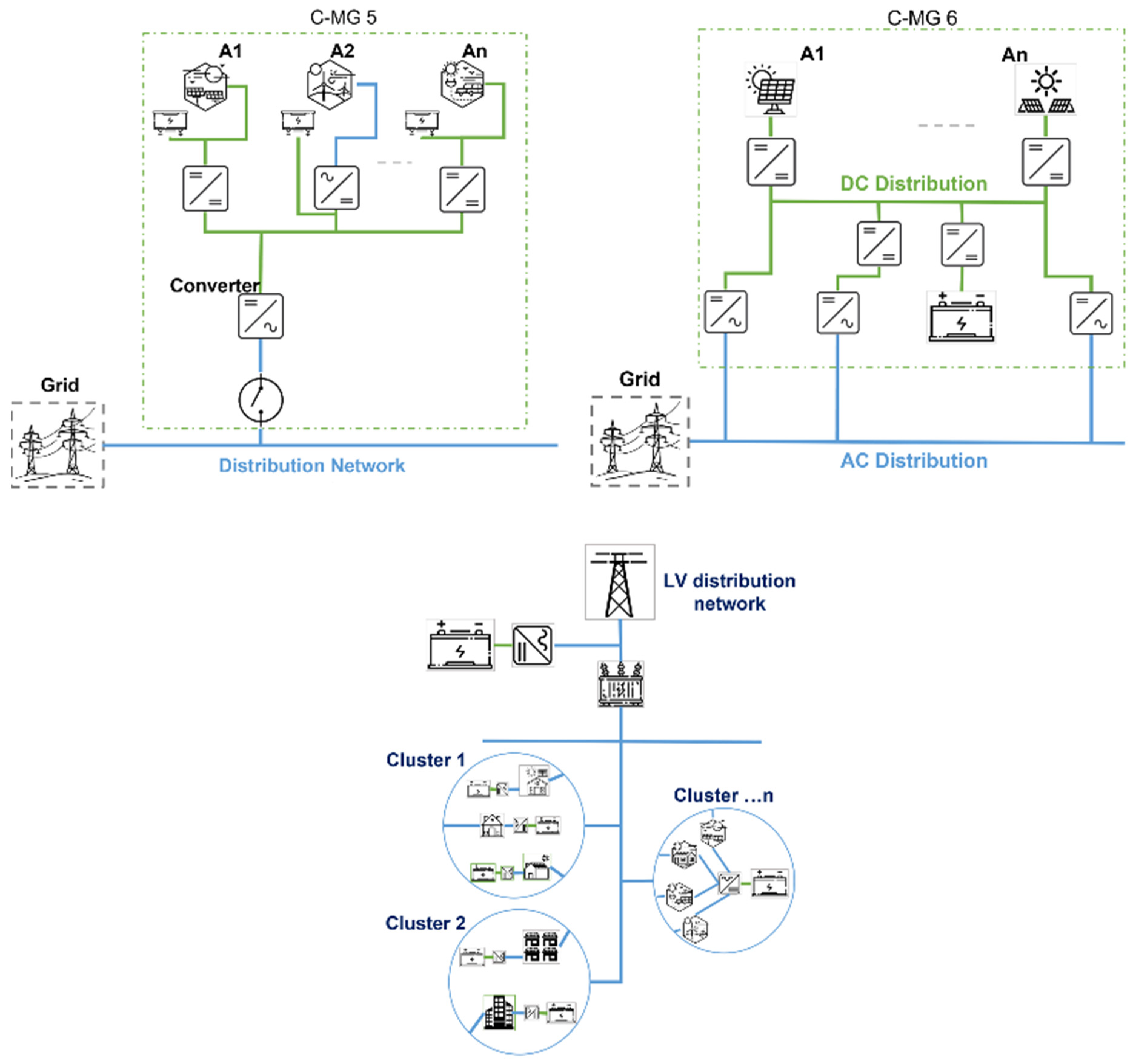

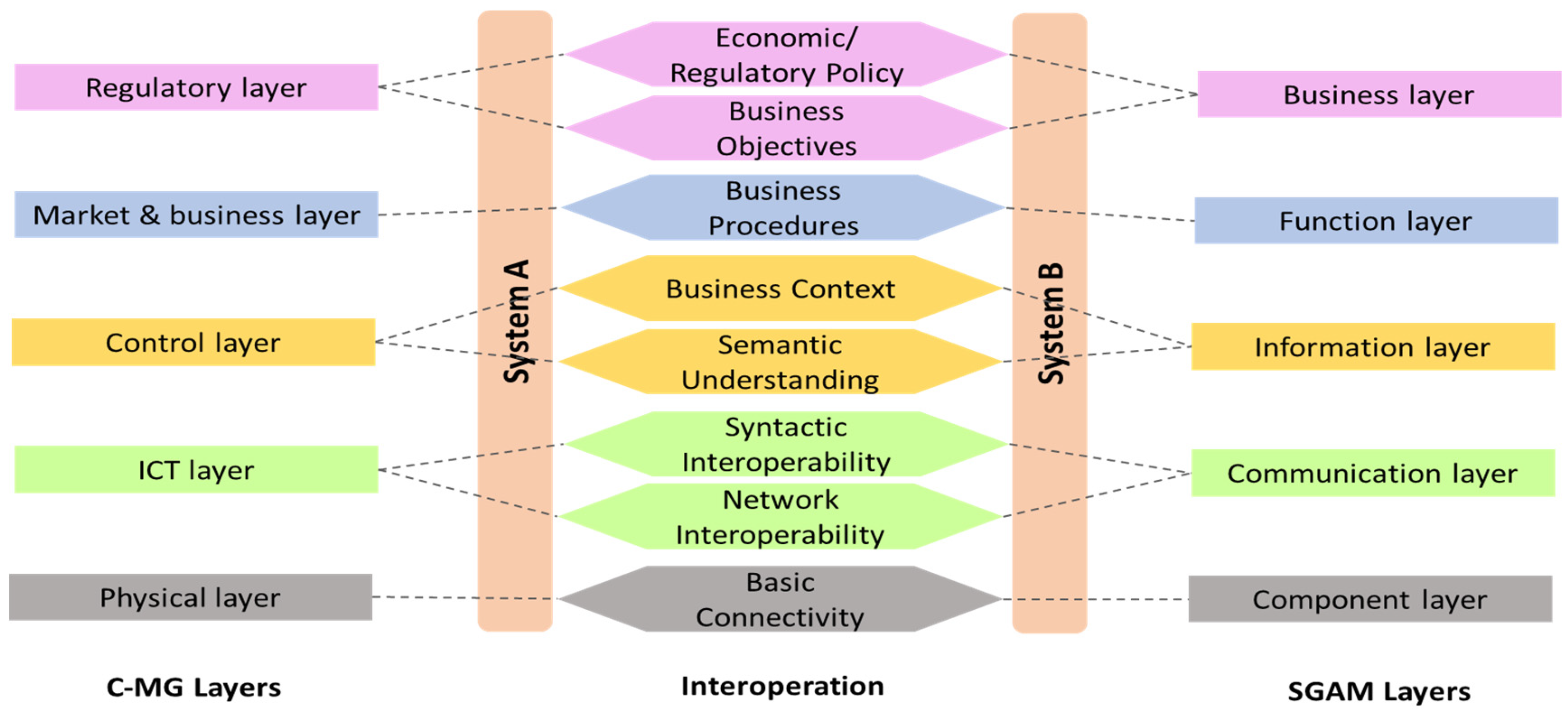
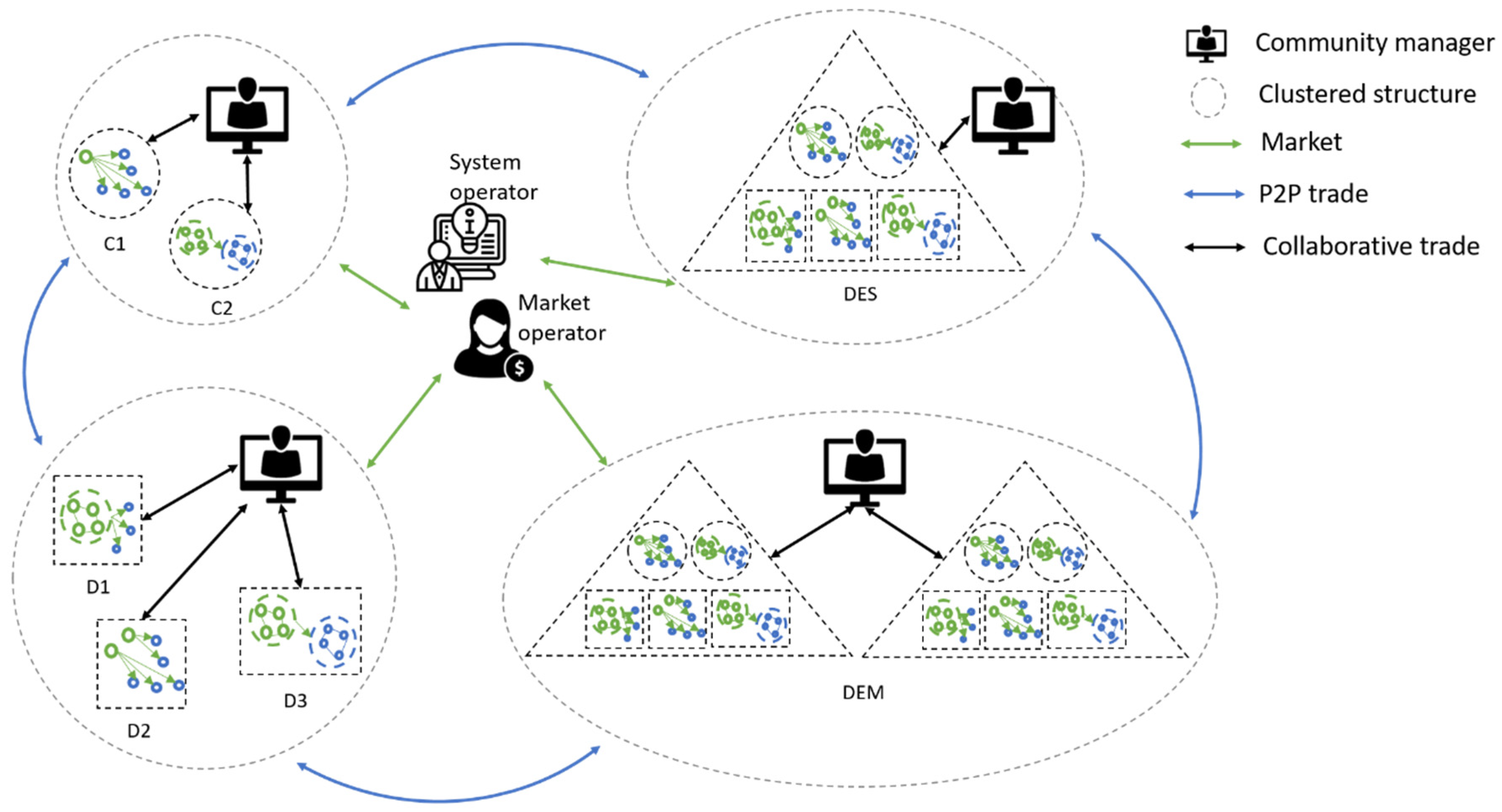
| SGAM | Microgrid Architecture | |||||
|---|---|---|---|---|---|---|
| [22] | [20] | [23] | [24] | [25] | [26] | This Work |
| Component layer | Power Grid layer | Device layer | Infrastructure layer | Physical equipment | Infrastructure | Physical layer |
| Comm. layer | ICT layer | Smart meter layer | Comm. Layer | Protection and control | Communications | ICT layer |
| Information layer | Transmission layer | Intelligence layer | Automation and control | Operation and control | Control layer | |
| Function layer | Control layer | Communication layer | Optimisation and dispatch | Climate conditions | Market and business | |
| Business layer | Business layer | Management layer | Business models | Market operations | Business | |
| Regulatory framework | Policies and standards | Regulatory layer | ||||
| Structures | Advantages | Disadvantages |
|---|---|---|
| Centralised |
|
|
| Distributed |
|
|
| Decentralised |
|
|
| Type [Ref] | Advantages | Disadvantages |
|---|---|---|
| C-MG1 [35] |
|
|
| C-MG2 [35] |
|
|
| C-MG3 [36] |
|
|
| C-MG4 [36] |
|
|
| C-MG5 [35] |
|
|
| C-MG6 [35] |
|
|
| C-MG7 |
|
|
| Standard/Authority | Issues Addressed |
|---|---|
| M/441 [52]/EU |
|
| M/468 [53]/EU |
|
| M/490 [54]/EU |
|
| M/530 [55]/EU |
|
| IEEE 1547 [56] |
|
| IEEE 2030 [57] |
|
| IEEE 2040 [58] |
|
| IEEE 802 [59] |
|
| IEC 61850 [60] |
|
| IEC 61970 [61] |
|
| IEC 62325 [61] |
|
| LEM Layers [65] | Proposed C-MG Layers |
|---|---|
| Physical layer | Physical layer |
| ICT layer | ICT layer |
| Market | Control layer |
| Socio-economic layer | Market and business |
| Policy and Regulatory layer | Regulatory layer |
| C-MG Structure | Control Prospective | Grid Flexibility | Market Perspective | Social Engagement | ||
|---|---|---|---|---|---|---|
| Centralised | Distributed | Decentralised | LEM/Wholesale * | |||
| C-MG1 | X | √ | √ | Low | LEM | Low |
| C-MG2 | √ | √ | Moderate | LEM/Wholesale * | Moderate | |
| C-MG3 | √ | X | X | Low | LEM/Wholesale * | Moderate |
| C-MG4 | √ | X | X | High | LEM/Wholesale * | High |
| C-MG5 | √ | X | X | High | LEM/Wholesale * | Moderate |
| C-MG6 | X | √ | √ | Low | LEM/Wholesale * | Moderate |
| C-MG7 | √ | √ | √ | Low-High | LEM/Wholesale * | High |
Publisher’s Note: MDPI stays neutral with regard to jurisdictional claims in published maps and institutional affiliations. |
© 2022 by the authors. Licensee MDPI, Basel, Switzerland. This article is an open access article distributed under the terms and conditions of the Creative Commons Attribution (CC BY) license (https://creativecommons.org/licenses/by/4.0/).
Share and Cite
Trivedi, R.; Patra, S.; Sidqi, Y.; Bowler, B.; Zimmermann, F.; Deconinck, G.; Papaemmanouil, A.; Khadem, S. Community-Based Microgrids: Literature Review and Pathways to Decarbonise the Local Electricity Network. Energies 2022, 15, 918. https://doi.org/10.3390/en15030918
Trivedi R, Patra S, Sidqi Y, Bowler B, Zimmermann F, Deconinck G, Papaemmanouil A, Khadem S. Community-Based Microgrids: Literature Review and Pathways to Decarbonise the Local Electricity Network. Energies. 2022; 15(3):918. https://doi.org/10.3390/en15030918
Chicago/Turabian StyleTrivedi, Rohit, Sandipan Patra, Yousra Sidqi, Benjamin Bowler, Fiona Zimmermann, Geert Deconinck, Antonios Papaemmanouil, and Shafi Khadem. 2022. "Community-Based Microgrids: Literature Review and Pathways to Decarbonise the Local Electricity Network" Energies 15, no. 3: 918. https://doi.org/10.3390/en15030918
APA StyleTrivedi, R., Patra, S., Sidqi, Y., Bowler, B., Zimmermann, F., Deconinck, G., Papaemmanouil, A., & Khadem, S. (2022). Community-Based Microgrids: Literature Review and Pathways to Decarbonise the Local Electricity Network. Energies, 15(3), 918. https://doi.org/10.3390/en15030918











